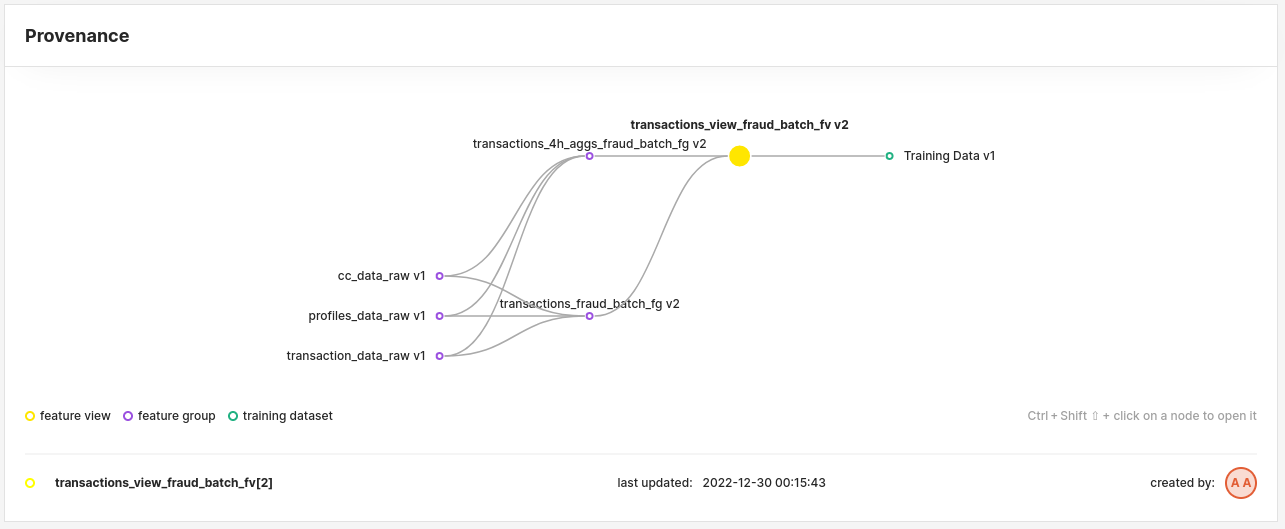Provenance#
Introduction#
Hopsworks feature store allows users to track provenance (lineage) between feature groups, feature views and training dataset. Tracking lineage allows users to determine where/if a feature group is being used. You can track if feature groups are being used to create additional (derived) feature groups or feature views.
You can interact with the provenance graph using the UI and the APIs.
Step 1: Feature group lineage#
Assign parents to a feature group#
When creating a feature group, it is possible to specify a list of feature groups used to create the derived features. For example, you could have an external feature group defined over a Snowflake or Redshift table, which you use to compute the features and save them in a feature group. You can mark the external feature group as parent of the feature group you are creating by using the parents parameter in the get_or_create_feature_group or create_feature_group methods:
# Retrieve the feature group
profiles_fg = fs.get_external_feature_group("user_profiles", version=1)
# Do feature engineering
age_df = transaction_df.merge(profiles_fg.read(), on="cc_num", how="left")
transaction_df["age_at_transaction"] = (age_df["datetime"] - age_df["birthdate"]) / np.timedelta64(1, "Y")
# Create the transaction feature group
transaction_fg = fs.get_or_create_feature_group(
name="transaction_fraud_batch",
version=1,
description="Transaction features",
primary_key=["cc_num"],
event_time="datetime",
parents=[profiles_fg]
)
transaction_fg.insert(transaction_df)
Another example use case for derived feature group is if you have a feature group containing features with daily resolution and you are using the content of that feature group to populate a second feature group with monthly resolution:
# Retrieve the feature group
daily_transaction_fg = fs.get_feature_group("daily_transaction", version=1)
daily_transaction_df = daily_transaction_fg.read()
# Do feature engineering
cc_group = daily_transaction_df[["cc_num", "amount", "datetime"]] \
.groupby("cc_num") \
.rolling("1M", on="datetime")
monthly_transaction_df = pd.DataFrame(cc_group.mean())
# Create the transaction feature group
monthly_transaction_fg = fs.get_or_create_feature_group(
name="monthly_transaction_fraud_batch",
version=1,
description="Transaction features - monthly aggregates",
primary_key=["cc_num"],
event_time="datetime",
parents=[daily_transaction_fg]
)
monthly_transaction_fg.insert(monthly_transaction_df)
List feature group parents#
You can query the provenance graph of a feature group using the UI and the APIs. From the APIs you can list the parent feature groups by calling the method get_parent_feature_groups
lineage = transaction_fg.get_parent_feature_groups()
# List all accessible parent feature groups
lineage.accessible
# List all deleted parent feature groups
lineage.deleted
# List all the inaccessible parent feature groups
lineage.inaccessible
A parent is marked as deleted (and added to the deleted list) if the parent feature group was deleted. inaccessible if you no longer have access to the parent feature group (e.g. the parent feature group belongs to a project you no longer have access to).
To traverse the provenance graph in the opposite direction (i.e. from the parent feature group to the child), you can use the get_generate_feature_groups method. When navigating the provenance graph downstream, the deleted feature groups are not tracked by provenance, as such, the deleted property will always return an empty list.
lineage = transaction_fg.get_generated_feature_groups()
# List all accessible child feature groups
lineage.accessible
# List all the inaccessible child feature groups
lineage.inaccessible
You can also visualize the relationship between the parent and child feature groups in the UI. In each feature group overview page you can find a provenance section with the graph of parent feature groups and child feature groups/feature views.

Step 2: Feature view lineage#
The relationship between feature groups and feature views is captured automatically when you create a feature view. You can inspect the relationship between feature groups and feature views using the APIs or the UI.
Using the APIs#
Starting from a feature view metadata object, you can traverse upstream the provenance graph to retrieve the metadata objects of the feature groups that are part of the feature view. To do so, you can use the get_parent_feature_groups method.
lineage = fraud_fv.get_parent_feature_groups()
# List all accessible parent feature groups
lineage.accessible
# List all deleted parent feature groups
lineage.deleted
# List all the inaccessible parent feature groups
lineage.inaccessible
You can also traverse the provenance graph in the opposite direction. Starting from a feature group you can navigate downstream and list all the feature views the feature group is used in. As for the derived feature group example above, when navigating the provenance graph downstream deleted feature views are not tracked. As such, the deleted property will always be empty.
lineage = transaction_fg.get_generated_feature_views()
# List all accessible downstream feature views
lineage.accessible
# List all the inaccessible downstream feature views
lineage.inaccessible
Using the UI#
In the feature view overview UI you can explore the provenance graph of the feature view:
